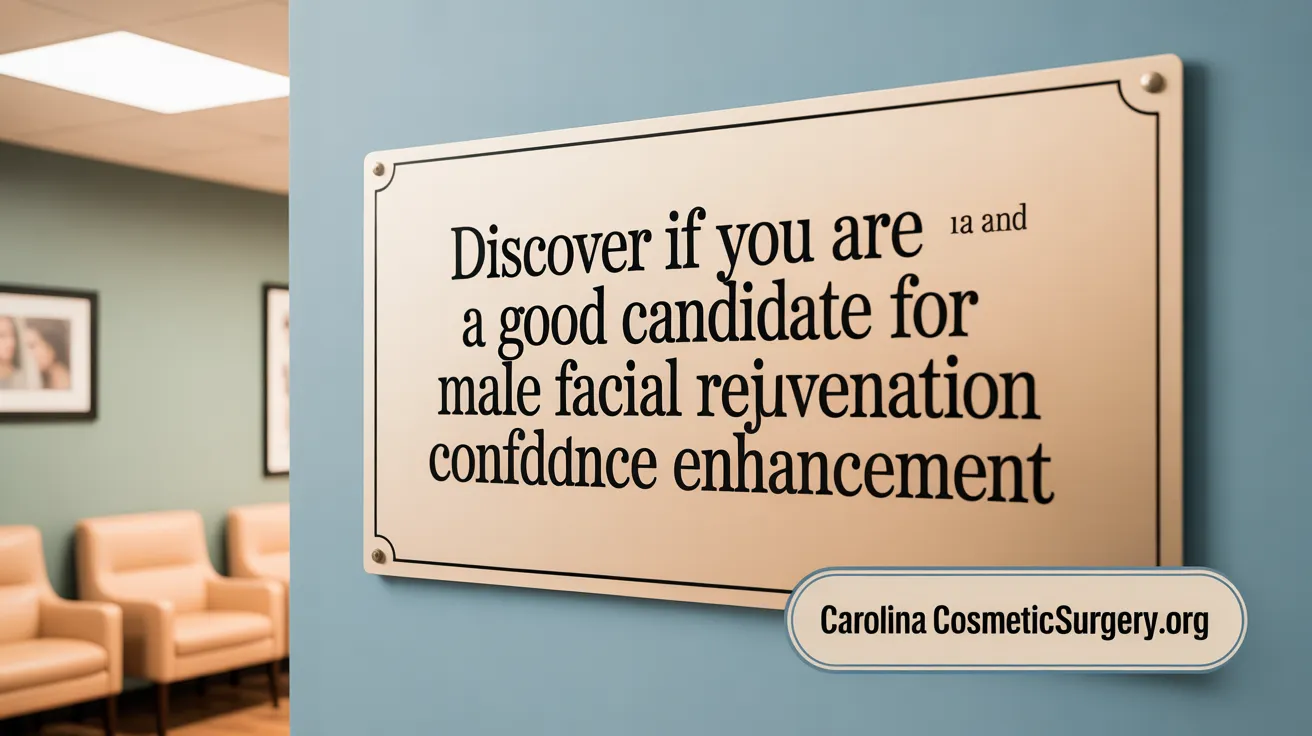Understanding the Male Facelift Journey
As more men seek to age gracefully without compromising their masculine features, the male facelift has emerged as a refined surgical solution tailored specifically to male anatomy and aesthetics. This guide explores the techniques, benefits, candidacy, recovery, and unique considerations that make male facelifts distinct and effective for rejuvenation.
What Is a Male Facelift and How Is It Performed?
What is a facelift and how is it performed on men?
A facelift, also known as rhytidectomy, is a surgical procedure designed to give men a more youthful and refreshed appearance. It involves tightening loose skin, smoothing deep wrinkles, and enhancing facial contours for a natural yet rejuvenated look.
Surgical steps tailored for men
For men, the procedure is customized to retain their masculine features. Surgeons often make incisions around the ears and within the hairline to hide scars effectively. The surgery includes lifting the skin, tightening underlying muscles—especially the SMAS layer—and removing excess skin. Special techniques like the deep plane facelift allow for deeper tissue repositioning, ensuring long-lasting results.
Difference in male anatomy impacting the procedure
Male facial anatomy influences how the facelift is performed. Men usually have thicker, oilier skin and stronger facial muscles than women. They also tend to have more pronounced jowling and fat deposits under the chin. These features require specialized surgical techniques to achieve natural-looking results without overly feminizing the face.
Types of facelift techniques for men
Several facelift options suit different needs:
- Traditional facelift
- Deep plane facelift
- SMAS plication
- Mini facelift Each method varies in invasiveness and the extent of tissue repositioning, allowing surgeons to customize based on the degree of aging and patient goals.
Incision placement and preservation of facial hair
Incisions are typically made around the ears and along the hairline, carefully placed to minimize visible scarring. For men with facial hair or beard stubble, incisions are meticulously designed to avoid damaging hair follicles, preserving facial hair patterns and maintaining a natural, masculine appearance.
Recovery timeline and expected duration of results
Post-surgery, men usually experience swelling and mild bruising for a few weeks. Most can return to light activities within a week or two. The final results become more apparent after about three weeks, with optimal healing occurring over several months. When combined with proper skincare and sun protection, the results can last 8 to 10 years, providing a substantial boost in facial vitality and confidence.
Distinctive Anatomical Features and Surgical Techniques in Male Facelifts

How do male facelift procedures differ from those performed on females?
Male facelift surgeries are specially tailored to account for the unique facial anatomy and aesthetic preferences of men. Men typically have thicker, greasier skin that is more resistant to tightening, and their facial tissues, muscles, and bones are more robust than those of women.
Surgeons usually place incisions higher along the hairline to hide scars within existing hair and to accommodate receding hairlines common in men. Facial hair preservation is also a priority; incisions around the beard area are carefully planned to avoid damaging hair follicles, maintaining a masculine appearance.
Because men's facial muscles are thicker and stronger, procedures like the deep plane facelift and SMAS plication are preferred to effectively lift and tighten tissue while respecting facial masculinity. These techniques help reposition deep structures for a natural result without over-tightening.
Moreover, due to the more prominent jawline and neck, surgeons focus on enhancing these features through targeted lifting and repositioning. Combining procedures such as neck lifts, liposuction, or skin resurfacing can further craft a balanced, masculine rejuvenation.
Overall, the approach emphasizes preserving masculine features—like a strong jawline and neck—while minimizing signs of aging. Customized surgical plans ensure results appear natural and maintain the man's facial identity, distinguishing male facelifts from those done on women.
Addressing Age-Related Changes in Men Through Facelifts
How does aging typically affect the male face, and how can a facelift address these changes?
Men generally experience noticeable aging signs such as sagging skin, deep wrinkles, and a less defined jawline. Over time, the skin loses elasticity, and fat deposits can shift, contributing to jowling and a drooping neck. Their stronger facial muscles and thicker skin can make these changes more prominent.
A facelift surgically targets these issues by tightening the underlying muscles and repositioning fat to restore a more youthful, masculine look. The procedure involves removing excess skin and lifting sagging tissues, particularly around the jawline and neck, to improve contour and definition.
To complement this, surgeons often combine other treatments like neck lifts, chin enhancements, or eyelid surgeries. These combined approaches help achieve a harmonious, refreshed appearance while maintaining masculine features.
Choosing an experienced surgeon ensures that the results are natural and tailored to the patient’s facial anatomy. Post-surgery skincare and lifestyle adjustments are crucial in prolonging the effects, often lasting over a decade. The careful balance of technical skill and aesthetic judgment is vital to provide enduring facial rejuvenation that respects the unique male anatomy.
Benefits and Expected Outcomes of a Male Facelift

What are the benefits and potential results of a male facelift?
A male facelift provides multiple advantages tailored to preserve masculine features and restore a youthful appearance. It primarily reduces deep wrinkles, sagging skin, and jowling, which are common signs of aging in men. The procedure helps tighten and lift underlying tissues, improving jawline definition and neck contours while maintaining a natural look.
Men often experience a significant repositioning of facial volume and contour adjustments, bringing back a more energetic and vibrant appearance. By carefully addressing issues like loose skin and volume loss, it helps restore the strong, angular features that define masculinity.
Results are designed to last between 8 to 10 years with proper skincare and lifestyle maintenance. Advances in surgical techniques focus on creating results that look natural, avoiding the 'pulled' or overly feminine look that can sometimes occur with less tailored procedures.
Facelift surgery can remarkably boost confidence, influence personal interactions, and even positively impact career prospects by enhancing facial presence and perceived vitality.
In many cases, combining a facelift with procedures like eyelid surgery, dermal fillers, or skin resurfacing enhances overall rejuvenation, producing more comprehensive smiles at enhanced self-esteem.
While the scars are hidden along natural creases and behind the ears, strategic incision placement ensures minimal visible scarring and a quicker, more comfortable recovery. Results from a skilled, experienced surgeon who specializes in male facial anatomy will look balanced and natural, emphasizing a masculine, chiseled appearance.
Overall, male facelift surgery offers a significant transformation that can restore confidence and promote a more youthful, vigorous look—crucial for those seeking a rejuvenated appearance tailored to masculine features.
Identifying Good Candidates for Male Facial Rejuvenation

Who is a good candidate for male facial rejuvenation procedures?
Ideal candidates for male facial rejuvenation procedures, such as facelift surgery, are generally healthy men who are beginning to show signs of aging in their face. These signs include sagging skin, deeper wrinkles, jowls, and loss of definition in the jawline. Most men seeking these procedures are typically in their 40s to 60s, although age can vary depending on individual skin condition and genetics.
Having good skin elasticity and a prominent bone structure are important factors that contribute to a natural, masculine result. Men with thicker and greasier skin often require specialized surgical techniques to achieve optimal outcomes. Candidates should be non-smokers, as smoking can impair healing and affect results. Additionally, they should be in overall good health, without serious medical issues that could complicate surgery or recovery.
Realistic expectations are crucial for satisfaction. Candidates should understand that a facelift can dramatically improve appearance by addressing sagging skin, wrinkles, and loss of volume, but it cannot reverse all effects of aging or alter facial features unnaturally.
The consultation process is pivotal. Experienced surgeons will assess skin quality, bone structure, and facial anatomy. Bringing recent photographs enables surgeons to plan personalized procedures that highlight masculine features, such as a strong jawline and neck contour.
Some men opt for combined or staged procedures, including eyelid lifts, neck lifts, or fat grafting, to achieve a comprehensive rejuvenation. Selecting an expert surgeon familiar with male anatomy and aesthetic goals is essential for natural and masculine-looking results.
Thus, good candidates are men who prioritize their appearance, have specific age-related concerns, and seek subtle yet impactful improvements—making them ideal for tailored male facelift procedures.
Navigating the Male Facelift Recovery Process
 After a male facelift, the recovery journey is marked by some common experiences and important care steps. Initially, patients often notice swelling, bruising, and mild discomfort. These symptoms tend to peak within the first few days post-surgery and gradually lessen over the following weeks.
After a male facelift, the recovery journey is marked by some common experiences and important care steps. Initially, patients often notice swelling, bruising, and mild discomfort. These symptoms tend to peak within the first few days post-surgery and gradually lessen over the following weeks.
During the first week, resting is essential. Patients should keep their head elevated, use cold packs to reduce swelling, and wear a compression garment as advised by their surgeon. Strenuous activities are typically restricted for at least two to three weeks to prevent complications.
Sutures are usually removed within 7 to 14 days after surgery. Most men can resume light activities within this timeframe, but full recovery, including the reduction of swelling, may take several months. Residual numbness and minor swelling can persist for up to a year, as tissues continue to settle and scars mature.
Follow-up visits are crucial during this period. Regular assessments allow the surgeon to monitor healing, remove sutures, and address any concerns promptly. Proper postoperative care also involves avoiding excessive sun exposure, smoking, and maintaining a healthy lifestyle.
Adhering to these guidelines ensures optimal healing and long-lasting results. Patience and careful follow-through with your surgeon’s instructions are vital for achieving a natural, masculine appearance that restores confidence and rejuvenates facial features.
Recognizing Signs of a Male Facelift: What to Look For
What are some indicators that a man might have had a facelift?
Detecting a male facelift involves observing specific signs and subtle clues. One common indicator is visible scarring, which often appears along the hairline, around the ears, or under the chin due to surgical incisions. These scars are usually discreet but can be noticeable upon close inspection.
Another sign can be an unnatural or "frozen" facial expression. Men who have undergone a facelift might display limited facial mobility, resulting in a stiff or overly smooth appearance that lacks the natural variability of genuine expressions.
The overall facial features can also provide hints. A more defined jawline and tighter skin are typical results, especially along the lower face and neck, which often change visibly after surgery.
Deformities such as pixie ears—where the earlobes appear pulled or look abnormal—or pinched nose tips may occasionally occur due to surgical procedures, though these are less common with skillful surgeons.
Post-surgical swelling or bruising might also be evident, but these signs are often concealed with careful makeup or styling, especially in the early stages of recovery.
Lastly, differences between subtle and overt results are essential to note. The most successful male facelifts aim for natural look—only a slight enhancement that preserves masculinity—while overt or exaggerated results can seem less authentic. Recognizing these signs can help differentiate between a well-executed procedure and an overly dramatic transformation.
Searching for further clues
If you're interested in understanding more about facial rejuvenation signs or considering a male facelift, searching for terms like "Signs and indicators of male facelift surgery" can offer detailed insights into the physical evidence and what to expect postoperatively.
The Importance of Choosing a Qualified Surgeon for Male Facelifts

Credentials and Board Certification
When considering a male facelift, one of the most crucial steps is selecting a surgeon with the proper credentials. Board-certified plastic surgeons have undergone extensive training and passed rigorous exams, ensuring they meet high standards of safety and skill. Certification from reputable boards like the American Board of Plastic Surgery signals compliance with safety, ethics, and operational excellence.
Experience with Male-Specific Techniques
Male facial anatomy presents unique challenges, such as thicker skin, stronger muscles, and specific hair patterns. Surgeons experienced in male procedures understand these nuances and employ customized techniques to preserve masculinity and natural features. Special skills like deep plane facelifts and regenerative facial fat grafting help achieve long-lasting, authentic results.
Reviewing Before-and-After Galleries
Before committing, prospective patients should carefully review the surgeon’s portfolio of before-and-after images. These galleries demonstrate the surgeon’s ability to produce natural, masculine outcomes that enhance features like a defined jawline and strong chin—elements central to male beauty standards. It also helps ensure that their aesthetic goals align with the surgeon’s expertise.
Consultation Process and Personalized Planning
A thorough consultation is vital for customizing the procedure. Leading surgeons assess facial structure, skin elasticity, and aging signs while discussing goals like maintaining a rugged jawline or reducing jowling. Personalized treatment plans may include complementary procedures such as eyelid surgery or skin resurfacing to optimize results.
Surgeon’s Role in Maintaining Masculinity and Natural Look
Achieving a natural, masculine appearance requires finesse. Skilled surgeons understand how to avoid an overly 'pulled' look, which can undermine masculinity. They focus on strategic lifting and meticulous incision placement, often behind the ears or within hairlines, to conceal scars and preserve facial character.
Use of Advanced and Regenerative Technologies
Many top surgeons incorporate cutting-edge techniques, including regenerative treatments like facial fat grafting, to restore youthful volume naturally. They also utilize advanced surgical methods like SMAS plication and laser-assisted skin tightening for longer-lasting results while minimizing visible scarring.
| Criteria | Details | Why It Matters |
|---|---|---|
| Credentials | Board certification, specialized training | Ensures safety and expertise |
| Male-specific experience | Familiarity with men's facial anatomy and aging patterns | Results that look natural and masculine |
| Portfolio review | Before-and-after results display | Confidence in the surgeon’s skills |
| Consultation approach | Personalized assessment and planning | Tailors procedure to individual needs |
| Focus on masculinity | Techniques to preserve rugged features | Maintains gender-appropriate aesthetics |
| Technology and techniques | Advanced surgical methods and regenerative treatments | Enhances longevity and natural appearance |
Choosing an experienced, qualified surgeon is essential for achieving a rejuvenated look that remains authentic to male features. A careful selection process combining credentials, experience, visual proof, and personalized care ensures optimal results with safety and confidence.
Enhancing and Maintaining Results Through Complementary Procedures and Lifestyle
How can adjunct treatments like eyelid surgery, dermal fillers, and skin resurfacing improve facelift results?
Complementary procedures are often combined with a male facelift to achieve a more comprehensive rejuvenation. Eyelid surgery (blepharoplasty) can address sagging and puffiness around the eyes, which often age a man's appearance prematurely. Dermal fillers help restore lost volume in the cheeks and temples, lifting and smoothing deep folds. Skin resurfacing treatments, such as laser or chemical peels, improve skin texture, tone, and tighten loose skin.
Are non-surgical options effective and how do they complement the facelift?
Non-surgical treatments like Botox, radiofrequency skin tightening, and ultrasound therapy can be used alongside surgical procedures to enhance results. These options offer less invasive ways to address early signs of aging and maintain a refreshed look over time. While they do not replace a facelift, they complement the surgery by prolonging its effects and targeting specific skin concerns.
Why is skincare and sun protection vital after a facelift?
Post-surgery, skin is more vulnerable, making daily skincare and diligent sun protection essential for preserving results. Using broad-spectrum sunscreen, moisturizing regularly, and adopting a skincare routine with antioxidants can prevent further damage. Good skincare habits help maintain skin elasticity and color, supporting the longevity of the surgical outcome.
What role does smoking cessation and healthy living play?
Quitting smoking and following a healthy lifestyle are crucial for optimal healing and long-lasting results. Smoking impairs blood flow, delays healing, and increases the risk of complications. Maintaining a balanced diet, staying hydrated, exercising regularly, and avoiding harmful habits promote better recovery and prolonged youthful appearance.
How long do results last, and are touch-ups necessary?
With proper care, most male facelift results can last 8 to 10 years. Over time, natural aging continues, and some men may opt for minor touch-up procedures or non-surgical treatments to maintain their appearance. Regular follow-up visits with your surgeon help monitor changes and plan appropriate maintenance.
What are the psychological benefits of facelift surgery?
Achieving a more youthful, masculine face can significantly boost confidence and self-esteem. Many men find that an improved appearance positively impacts their personal and professional lives, fostering greater self-assurance and overall well-being.
| Aspect | Details | Additional Notes |
|---|---|---|
| Adjunct treatments | Eyelid surgery, fillers, skin resurfacing | For targeted best results |
| Non-surgical options | Botox, skin tightening | Support surgical outcomes |
| Post-op skincare | Sun protection, moisturizers | Maintain results |
| Lifestyle tips | Quit smoking, healthy diet | Promote healing and longevity |
| Longevity | 8-10 years, with maintenance | Regular touch-ups |
| Psychological | Confidence boost | Personal and social benefits |
Embracing a Youthful, Masculine Future
A male facelift offers a sophisticated approach to aging that respects and enhances masculine features while providing substantial rejuvenation. With techniques tailored to the unique male anatomy and comprehensive pre- and post-surgical care, men can achieve natural, confident results that last for years. Selecting a skilled surgeon and maintaining a healthy lifestyle are critical for maximizing these benefits. Ultimately, male facelifts empower men to age gracefully, embracing a vibrant appearance and renewed self-assurance.
References
- Facelifts for Men: A Comprehensive Guide to Masculine Rejuvenation
- Male Facelift In New York City - Dr. Andrew Timberlake
- Facelift for Men - Claytor Noone Plastic Surgery
- Facelift for Men: Addressing Age-Related Changes
- Facelift for Men | Male Neck Lift Wilmette, IL - Anthony Terrasse, MD
- Male Face Lift in Miami, FL | Wrinkle Reduction for Men
- Male Facelift in San Diego, CA | FACES+
